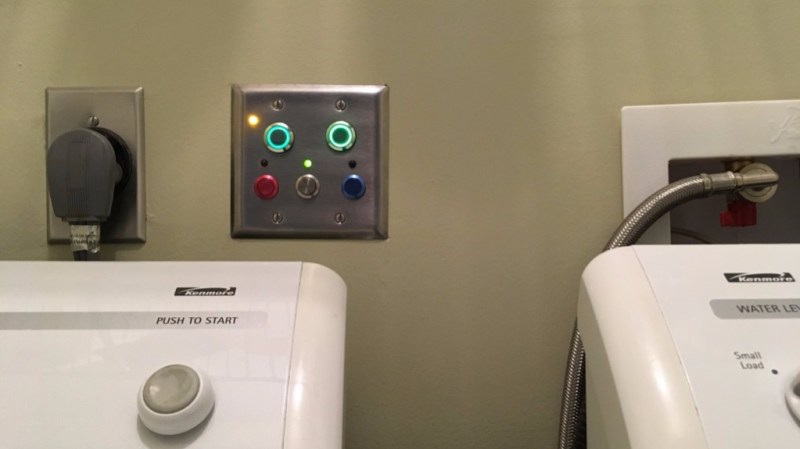If like us you live in mortal fear of someone breaking into your house when you’re on vacation and starting a dryer fire while doing laundry, this full-featured IoT laundry room monitor is for you. And there’s a school bus. But don’t ask about the school bus.
In what [seasider1960] describes as “a classic case of scope creep,” there’s very little about laundry room goings on that escapes the notice of this nicely executed project. It started as a water sensor to prevent a repeat of a leak that resulted in some downstairs damage. But once you get going, why not go too far? [seasider1960] added current sensing to know when the washer and dryer are operating, as well as to tote up power usage. A temperature sensor watches the dryer vent and warns against the potential for the aforementioned tragedy by sounding an obnoxious local alarm — that’s where the school bus comes in. The whole system is also linked into Blynk for IoT monitoring, with an equally obnoxious alarm you can hear in the video below. Oh, and there are buttons for testing each alarm and for making an Internet note to reorder laundry supplies.
We’ve seen a spate of laundry monitoring projects lately, all of which have their relative merits. But you’ve got to like the fit and finish of [seasider1960]’s build. The stainless face plate and in-wall mount makes for a sleek, professional appearance which is fitting with the scope-creepy nature of the build.















Oh god I love the school bus.
the best.
and what was the shiny thing for again?
It surely sounds promising but how will this monitor the internal parameters like the ‘supplies status’ ?
I think you reset a counter; just a rough estimate.
My guess is that whoever uses up enough of the laundry supplies that the purchase of more is required presses a button or something (which then adds it to some sort of online shopping list so the right person knows to buy more)
“Monitor All the Laundry Things with this Sleek IoT System”
Translation:
“THE MAN (China/Google/Insert Your-Government) Monitors All the Things in Your Life”…
And if Your Government doesn’t like what it sees… Buckle-Up Victim!
TL;DR: IoT=EVIL
I don’t see how it can notify me when the clothes outside on the clothesline are dry. Especially when they dry at different rates due to types of cloth, thickness, sunshine amount, wind…
Sunshine, wind, humidity are all easily measurable, so your only challenge is cloth type/thickness. Weight might provide a good first approximation.
Weight, I like that, have a strain guage on one end of each clothesline. It will need to be reconciled with current wind speed (and direction?) to compensate for wind loading.
what is scope creep?
That’s when the “scope” of the project “creeps” outside its original parameters (i.e. gets more complicated).
Oh! Thanks! I thought it had to do with an oscilloscope slowly edging off of the shelf above the test bench!
That could ruin a guys day!
I used a WeMo Insight and python to watch my washing machine status… I also logged the cycle in CSV format and then graphed it in Excel… Useless but fun! It’s nice to get a pushover alert / voice alert over the house speakers that the laundry is done because the feeble beeper is too quiet to hear anywhere but in the basement…
All your basement are belong to us.
Why don’t white goods manufacturers provide a common interface on the back of their products for accessing internal information? Surely some sort of consortium amongst the heavy hitters would solve a lot of the problems associated with IoT. Or make things accessible over the wire using the HomePlug standard, then they automatically become networked.
Because white goods manufacturers have no interest in working with other white goods manufacturers.
Kenmore and Whirlpool are made in the same factories by the same people, but have different part numbers for the same parts. Speed Queen, KitchenAid, Maytag, etc. are similar in that several different brand names are made in the same facilities with different part numbers.
You could argue that having inter-connectivity would add value. Look at the communications world, if a Cisco box couldn’t talk to a Netgear one, then it’s a bit useless. People (Customers) like to have choice, increasing the choice increases product value in my eyes.
Well, I’m just (farsically) saying, that the interface board(s) and connector would add cost to every machine. Right now, customers that want Internet connectivity (such as a refrigerator or coffee machine) pay they the extra cost for that connectivity. Right now the consumer demand for such connectivity is small.
Here’s an idea they might get sold on.
Require white goods to have a diagnostic plug (similar in concept to the OBD II on automobiles). Then a wireless
add on (such as the blueTooth dongles for OBD II ) would be an incremental step.
I think you’re on the right track there, a diagnostic connection would be a step closer and the manufacturers would probably see the benefit of having it.